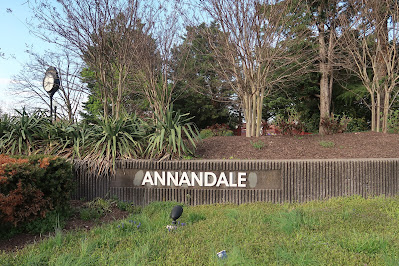Board of Supervisors endorses Annandale design guidelines
 |
| Tollhouse Park |
The Fairfax County Board of Supervisors on June 22 endorsed
the revised design guidelines for Annandale, which set forth recommendations
for streetscapes, buildings, landscaping, roads, and other architectural
elements and public amenities
The guidelines are aimed at creating a unified visual
concept for Annandale and encouraging pedestrian activity.
The board endorsed the Volume I Urban Design Guidelines for Commercial Revitalization Districts and Commercial Revitalization Areas in
2018, which set forth broad guidelines for all urban areas. Volume II District
Guidelines serve as a companion document to Volume I and provide character,
design, and placemaking ideas for specific areas.
The Annandale Commercial Revitalization District (CRD)
generally extends along Little River Turnpike between Evergreen Lane and
Medford Drive and along Columbia Pike to Gallows Road. The guidelines also
cover the Annandale Commercial Business Center (CBD), which encompasses the
same boundaries but also extends westward to Championship Drive.
Related story: Public urged to comment on revised Annandale design guidelines
The guidelines are not mandatory and are not intended to
dictate a particular architectural style or site design. Developers and landowners
are encouraged to use the guidelines as they design new projects, and the
county’s planning staff and Planning Commission use them to evaluate
development proposals.
Here are some key elements in Volume II District Guidelines for
Annandale:
- Parcels should be consolidated to allow maximum flexibility
in site layout. - Parking should be located away from the street frontage.
- Retail should be located on the ground floor to encourage
interaction with pedestrians. - Pocket parks and plazas should be used to expand sidewalks
in high-pedestrian traffic areas to accommodate dining, landscaping, or
seating. - Pedestrian and bicycle connections to open space and parks
should be improved. - Roof lines should incorporate such features as gables,
dormers, towers, balconies, terraces, and parapets. - Rather than blank walls, facades should incorporate a
variety of materials, murals, public art, arcades, windows, and other features
to create visual interest. - Building materials should use rough textures on the lower
sections of a façade and smooth textures on upper sections. Brick should be the
predominant material for buildings. Painted brick and vinyl siding should be
avoided.
 |
| Little River Turnpike |
- Parking structures should be underground or behind building
facades with access from side streets. Surface parking should only be used if
underground or structured parking is not feasible. - Loading areas should not be on main streets.
- Electric vehicle charging stations should be in the interior
of building sites or at least screened with landscaping. - The guidelines define certain types of roadways in the CBC
and recommend the travel lane widths, bicycle facilities, landscaping, and
other elements for each type. - The only boulevard in the CBC is Little River Turnpike.
Columbia Pike, Backlick Road, Ravensworth Road, Annandale Road, and Hummer Road
are avenues. Evergreen Lane, John Marr Drive, Markham Street, part of Medford
Drive, and Heritage Drive are collectors. Chatelain Road, Tom Davis Drive,
Daniels Avenue, Poplar Street, Martin Avenue, Maple Place, Woodland Road, and
parts of McWhorter Place, Medford Drive, and Champion Drive are local streets. - The guidelines suggest specific types of trees and plants
appropriate for streets, parks, and plazas. - Poured concrete should be used for sidewalks. Pavers can be
used in accent areas to support street furnishings within landscaped areas. - The guidelines encourage seating at regular intervals for
pedestrians and recommend certain styles of benches. - They also suggest certain styles for trashcans, bollards,
bike racks, bus shelters, wayfinding signs, and streetlights. - Public art should be incorporated into the functional realm
and should be provided at a variety of scales. Art should be located along
primary pedestrian corridors, in major parks and open spaces, and at building
entrances.


Great timing – I have started an initiative to get more trees planted along 236.
Could I join you on that?
–kda